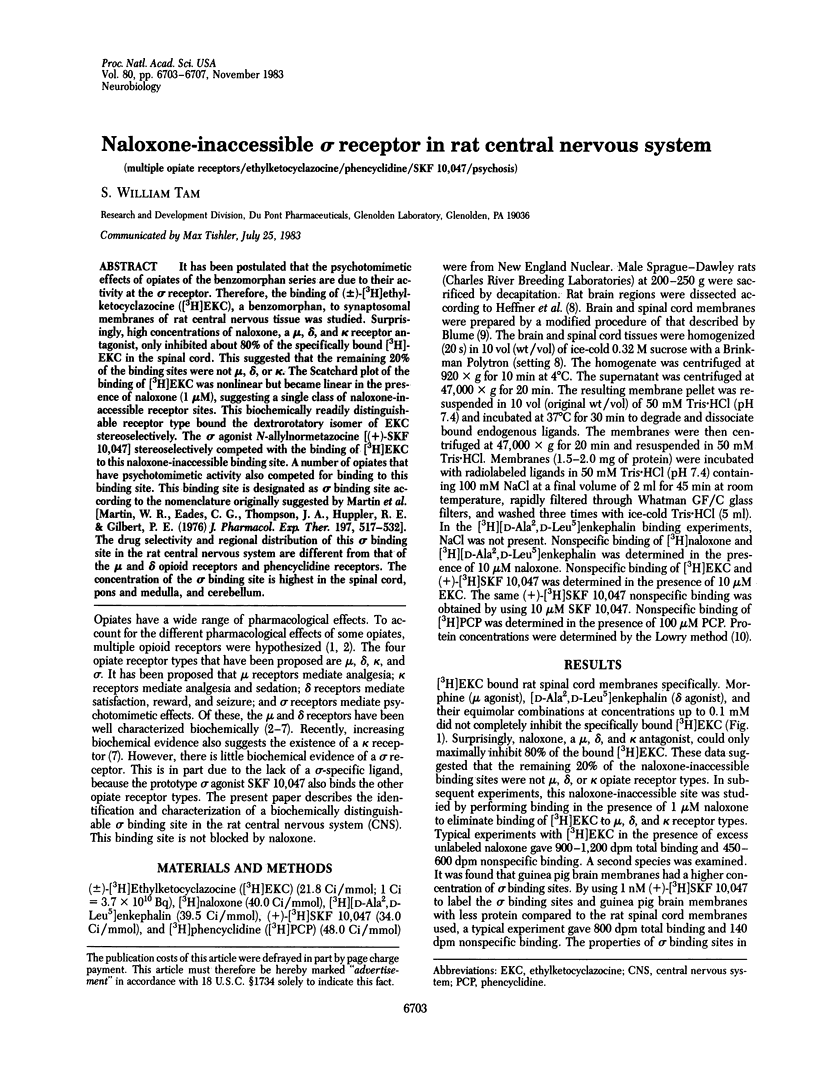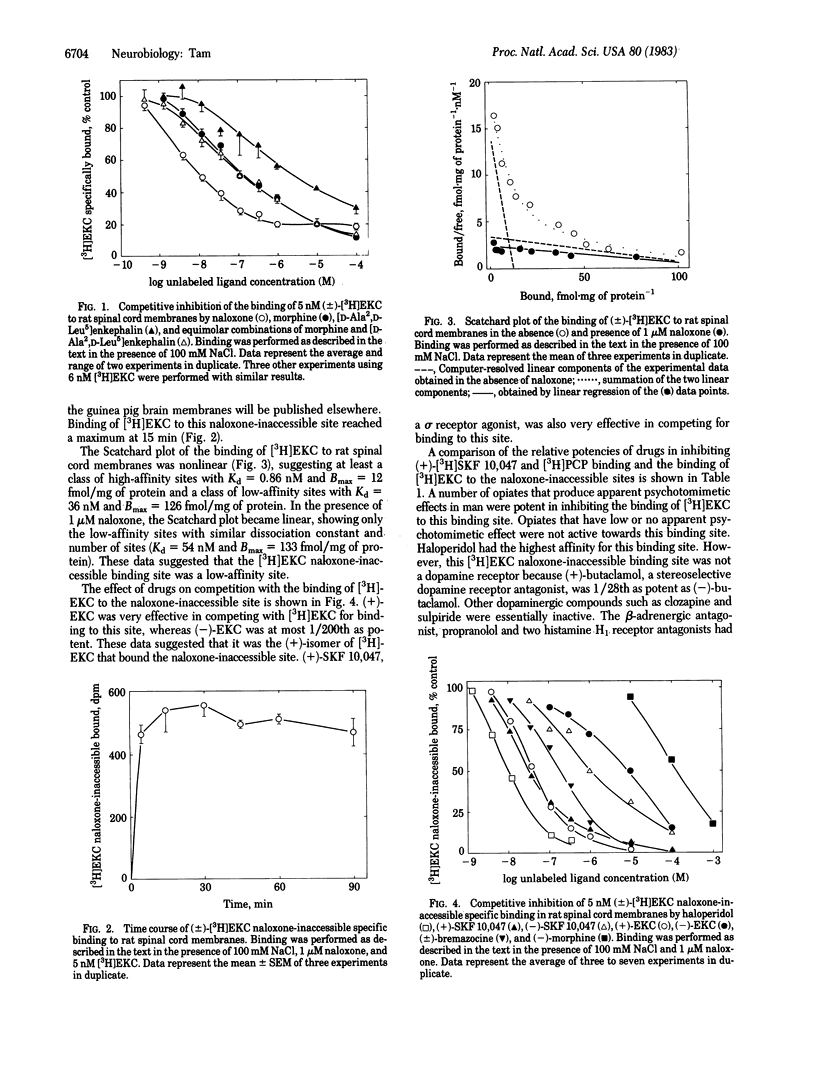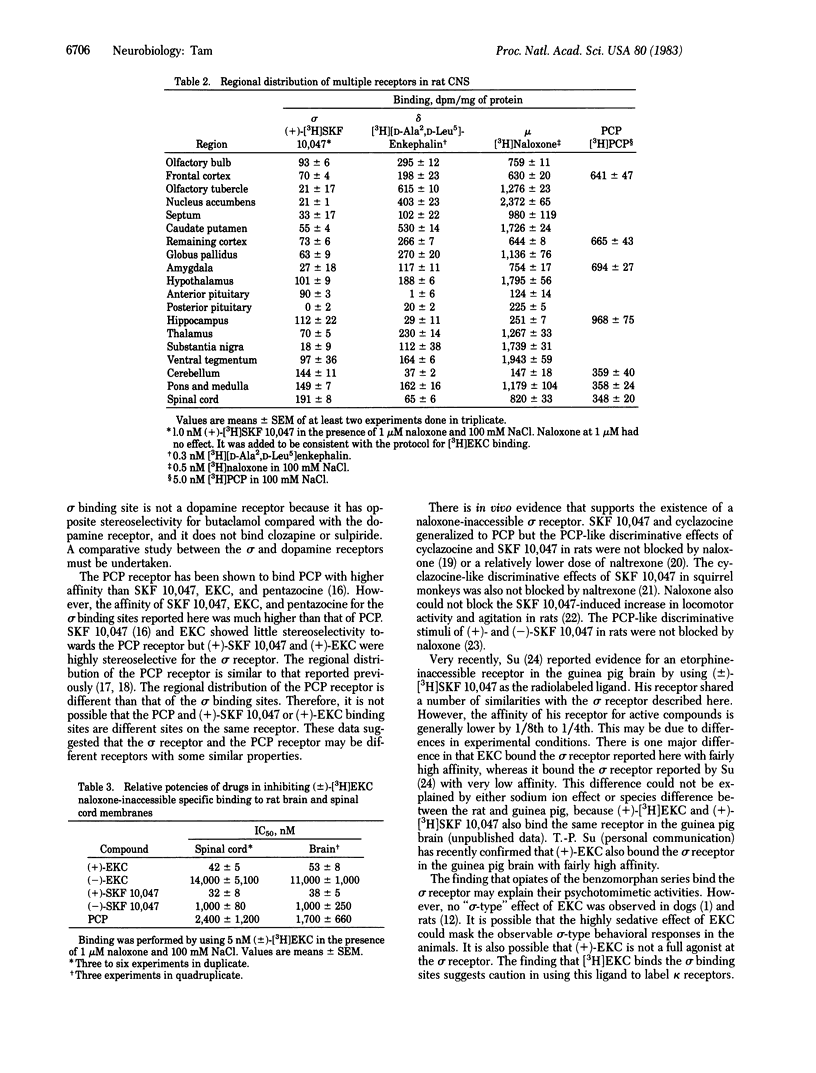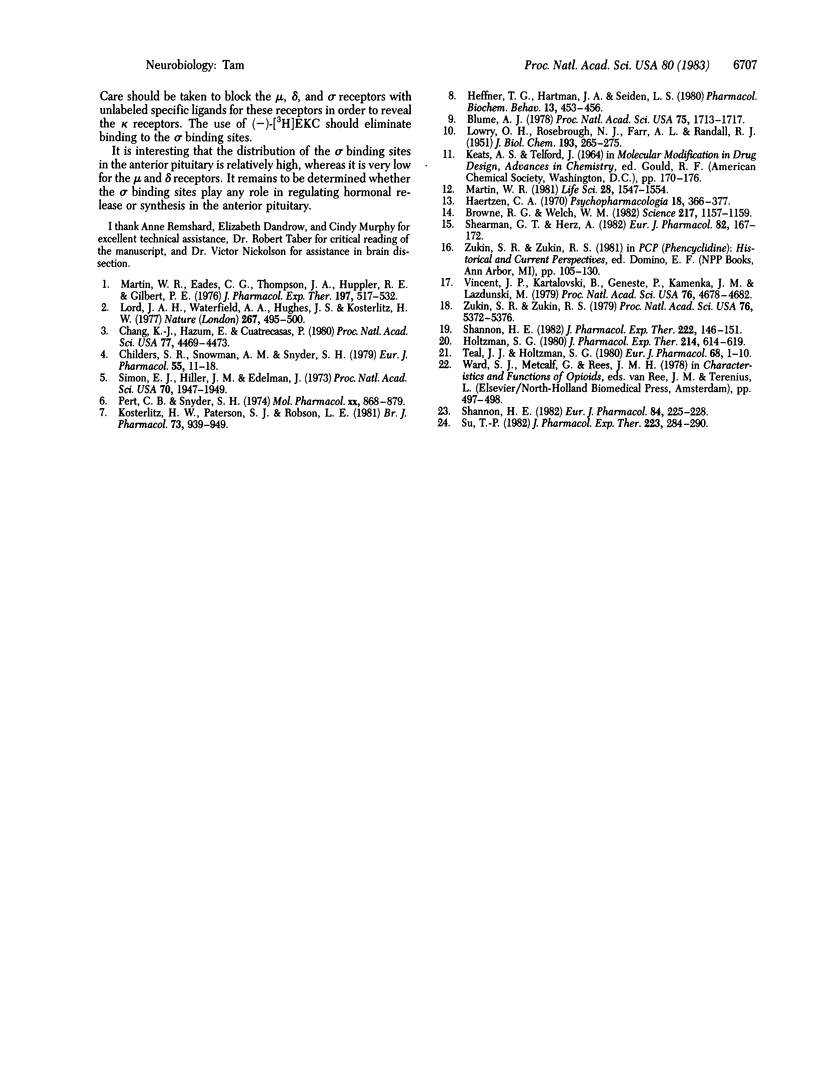Abstract
It has been postulated that the psychotomimetic effects of opiates of the benzomorphan series are due to their activity at the sigma receptor. Therefore, the binding of (+/-)-[3H]ethylketocyclazocine ( [3H]EKC), a benzomorphan, to synaptosomal membranes of rat central nervous tissue was studied. Surprisingly, high concentrations of naloxone, a mu, delta, and kappa receptor antagonist, only inhibited about 80% of the specifically bound [3H]EKC in the spinal cord. This suggested that the remaining 20% of the binding sites were not mu, delta, or kappa. The Scatchard plot of the binding of [3H]EKC was nonlinear but became linear in the presence of naloxone (1 microM), suggesting a single class of naloxone-inaccessible receptor sites. This biochemically readily distinguishable receptor type bound the dextrorotatory isomer of EKC stereoselectively. The sigma agonist N-allylnormetazocine [(+)-SKF 10,047] stereoselectively competed with the binding of [3H]EKC to this naloxone-inaccessible binding site. A number of opiates that have psychotomimetic activity also competed for binding to this binding site. This binding site is designated as sigma binding site according to the nomenclature originally suggested by Martin et al. [Martin, W. R., Eades, C. G., Thompson, J. A., Huppler, R. E. & Gilbert, P. E. (1976) J. Pharmacol. Exp. Ther. 197, 517-532]. The drug selectivity and regional distribution of this sigma binding site in the rat central nervous system are different from that of the mu and delta opioid receptors and phencyclidine receptors. The concentration of the sigma binding site is highest in the spinal cord, pons and medulla, and cerebellum.
Full text
PDF




Selected References
These references are in PubMed. This may not be the complete list of references from this article.
- Blume A. J. Interaction of ligands with the opiate receptors of brain membranes: regulation by ions and nucleotides. Proc Natl Acad Sci U S A. 1978 Apr;75(4):1713–1717. doi: 10.1073/pnas.75.4.1713. [DOI] [PMC free article] [PubMed] [Google Scholar]
- Browne R. G., Welch W. M. Stereoselective antagonism of phencyclidine's discriminative properties by adenosine receptor agonists. Science. 1982 Sep 17;217(4565):1157–1159. doi: 10.1126/science.6287578. [DOI] [PubMed] [Google Scholar]
- Chang K. J., Hazum E., Cuatrecasas P. Possible role of distinct morphine and enkephalin receptors in mediating actins of benzomorphan drugs (putative kappa and sigma agonists). Proc Natl Acad Sci U S A. 1980 Aug;77(8):4469–4473. doi: 10.1073/pnas.77.8.4469. [DOI] [PMC free article] [PubMed] [Google Scholar]
- Childers S. R., Creese I., Snowman A. M., Synder S. H. Opiate receptor binding affected differentially by opiates and opioid peptides. Eur J Pharmacol. 1979 Apr 1;55(1):11–18. doi: 10.1016/0014-2999(79)90142-0. [DOI] [PubMed] [Google Scholar]
- Haertzen C. A. Subjective effects of narcotic antagonists cyclazocine and nalorphine on the Addiction Research Center Inventory (ARCI). Psychopharmacologia. 1970;18(4):366–377. doi: 10.1007/BF00402763. [DOI] [PubMed] [Google Scholar]
- Heffner T. G., Hartman J. A., Seiden L. S. A rapid method for the regional dissection of the rat brain. Pharmacol Biochem Behav. 1980 Sep;13(3):453–456. doi: 10.1016/0091-3057(80)90254-3. [DOI] [PubMed] [Google Scholar]
- Holtzman S. G. Phencyclidine-like discriminative effects of opioids in the rat. J Pharmacol Exp Ther. 1980 Sep;214(3):614–619. [PubMed] [Google Scholar]
- Kosterlitz H. W., Paterson S. J., Robson L. E. Characterization of the kappa-subtype of the opiate receptor in the guinea-pig brain. Br J Pharmacol. 1981 Aug;73(4):939–949. doi: 10.1111/j.1476-5381.1981.tb08749.x. [DOI] [PMC free article] [PubMed] [Google Scholar]
- LOWRY O. H., ROSEBROUGH N. J., FARR A. L., RANDALL R. J. Protein measurement with the Folin phenol reagent. J Biol Chem. 1951 Nov;193(1):265–275. [PubMed] [Google Scholar]
- Lord J. A., Waterfield A. A., Hughes J., Kosterlitz H. W. Endogenous opioid peptides: multiple agonists and receptors. Nature. 1977 Jun 9;267(5611):495–499. doi: 10.1038/267495a0. [DOI] [PubMed] [Google Scholar]
- Martin W. R., Eades C. G., Thompson J. A., Huppler R. E., Gilbert P. E. The effects of morphine- and nalorphine- like drugs in the nondependent and morphine-dependent chronic spinal dog. J Pharmacol Exp Ther. 1976 Jun;197(3):517–532. [PubMed] [Google Scholar]
- Martin W. R. Multiple opioid receptors: a little about their history and some implications related to evolution. Life Sci. 1981 Apr 6;28(14):1547–1554. doi: 10.1016/0024-3205(81)90308-8. [DOI] [PubMed] [Google Scholar]
- Shannon H. E. Pharmacological analysis of the phencyclidine-like discriminative stimulus properties of narcotic derivatives in rats. J Pharmacol Exp Ther. 1982 Jul;222(1):146–151. [PubMed] [Google Scholar]
- Shannon H. E. Phencyclidine-like discriminative stimuli of (+)- and (-)-N-allylnormetazocine in rats. Eur J Pharmacol. 1982 Oct 22;84(3-4):225–228. doi: 10.1016/0014-2999(82)90207-2. [DOI] [PubMed] [Google Scholar]
- Shearman G. T., Herz A. Non-opioid psychotomimetic-like discriminative stimulus properties of N-allylnormetazocine (SKF 10,047) in the rat. Eur J Pharmacol. 1982 Aug 27;82(3-4):167–172. doi: 10.1016/0014-2999(82)90506-4. [DOI] [PubMed] [Google Scholar]
- Simon E. J., Hiller J. M., Edelman I. Stereospecific binding of the potent narcotic analgesic (3H) Etorphine to rat-brain homogenate. Proc Natl Acad Sci U S A. 1973 Jul;70(7):1947–1949. doi: 10.1073/pnas.70.7.1947. [DOI] [PMC free article] [PubMed] [Google Scholar]
- Su T. P. Evidence for sigma opioid receptor: binding of [3H]SKF-10047 to etorphine-inaccessible sites in guinea-pig brain. J Pharmacol Exp Ther. 1982 Nov;223(2):284–290. [PubMed] [Google Scholar]
- Teal J. J., Holtzman S. G. Discriminative stimulus effects of prototype opiate receptor agonists in monkeys. Eur J Pharmacol. 1980 Nov 7;68(1):1–10. doi: 10.1016/0014-2999(80)90053-9. [DOI] [PubMed] [Google Scholar]
- Vincent J. P., Kartalovski B., Geneste P., Kamenka J. M., Lazdunski M. Interaction of phencyclidine ("angel dust") with a specific receptor in rat brain membranes. Proc Natl Acad Sci U S A. 1979 Sep;76(9):4678–4682. doi: 10.1073/pnas.76.9.4678. [DOI] [PMC free article] [PubMed] [Google Scholar]
- Zukin S. R., Zukin R. S. Specific [3H]phencyclidine binding in rat central nervous system. Proc Natl Acad Sci U S A. 1979 Oct;76(10):5372–5376. doi: 10.1073/pnas.76.10.5372. [DOI] [PMC free article] [PubMed] [Google Scholar]


